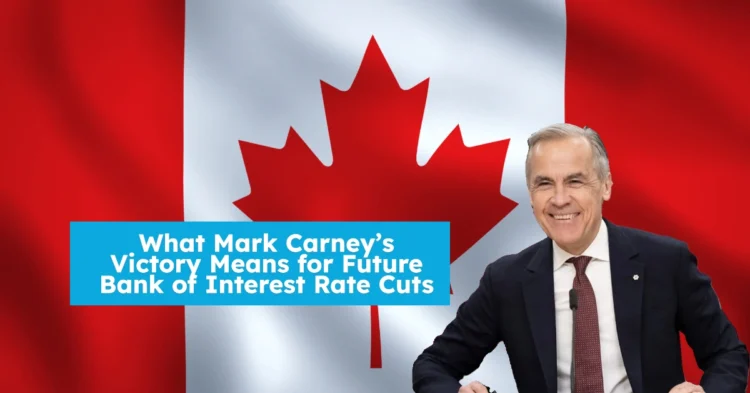he election of Mark Carney—former Bank of Canada and Bank of England governor—as Prime Minister of Canada has triggered widespread speculation about how his government’s aggressive fiscal agenda could affect the Bank of Canada’s (BoC) path for interest rate cuts in 2025. With the federal government set to inject nearly C$130 billion in fiscal stimulus, many analysts believe the BoC may not need to rely as heavily on monetary easing to support the economy.
Table of Contents
Carney’s Fiscal Push Could Ease Pressure on Central Bank
The Carney-led Liberal government has pledged significant spending across key sectors such as infrastructure, housing, defense, and resource development. This expansionary fiscal strategy is expected to stimulate growth and consumer demand. According to Carl Gomez, chief economist at CoStar Group Canada, this proactive fiscal stance could “take the onus off the central bank to cut as significantly as they did during past economic crises like COVID and the global financial crisis.”
Despite expectations that the BoC’s benchmark interest rate—currently at 2.75%—will fall further in 2025, analysts have softened their forecasts regarding how deep and fast those cuts will occur. The general consensus now leans toward a year-end policy rate of around 2.25%, with fewer cuts than initially projected.
Mark Carney Unveils $1,576 Monthly Support for Seniors Starting April 2025
New Canada Driving Rules for Seniors in 2025: Medical Tests and License Renewal Updates
All CRA Payments Coming in May 2025: Full List of Dates for CCP, CCB, Carbon Rebates & More
New $680 GST/HST Amount Coming in May 2025: Payment Dates, and Eligibility Explained
How Fiscal Policy Affects Monetary Easing
Ashish Dewan, senior investment strategist at Vanguard Canada, explains that while Carney’s leadership might not directly influence the BoC’s decisions, his government’s fiscal measures will inevitably play a role. “Increased fiscal spending reduces the likelihood of deeper rate cuts,” he notes.
Stephen Brown, deputy chief North America economist at Capital Economics, points to former BoC Governor Stephen Poloz’s past comments: “C$5 billion in stimulus is roughly equivalent to a 25-basis-point rate cut.” By that logic, the Liberal plan to widen the deficit by C$15 billion could offset the need for about 50 basis points in monetary easing.
Ongoing Trade Tensions Complicate BoC Outlook
At the same time, U.S. tariffs on Canadian goods continue to create inflationary pressure. JP Morgan strategist Jack Manley warns that prolonged trade disputes could dampen growth while nudging inflation upward. Yet, the BoC has signaled a willingness to prioritize support for the labor market and consumer spending—even if it allows inflation to run slightly above target.
This stance suggests more rate cuts may still be coming in 2025, although likely in smaller increments. According to RSM Canada economist Tu Nguyen, the Carney government’s fiscal plan “might be necessary to soften the blow of a recession while reducing the need for further rate cuts.” She expects two more rate cuts this year, ending the policy rate at 2.25%.
Central Bank Independence Remains Intact
One concern in financial circles has been whether Carney’s unique dual experience as a central banker and now head of government could blur the lines between fiscal and monetary authority. However, most experts agree Carney understands the importance of central bank independence.
BMO senior economist Shelly Kaushik says, “Broadly speaking, the Liberal platform promises more stimulus, which could add some marginal hawkishness to the Bank’s decisions,” but she also emphasizes that “Carney will not personally interfere with the BoC’s policy decisions.”
RBC’s Eric Lascelles echoes this view, stating that Carney “will well appreciate the importance of ensuring that fiscal policy does not work at odds with monetary policy—both small wins for the central bank.”
Trade Policy Will Shape the Rate Path Ahead
The trajectory of Canada–U.S. trade relations is now a key driver of future BoC decisions. As Kaushik explains, “Negotiating a favorable deal with President Trump remains Carney’s most urgent task.” Analysts like Dewan foresee a scenario with an average 10% U.S. tariff on Canadian goods, met with Canadian retaliation.
While this would raise inflation temporarily, Nguyen predicts it will likely be a one-time adjustment, not a long-term inflation trend. The BoC, therefore, will have to walk a fine line: keeping inflation in check while supporting growth in a turbulent global environment.
Conclusion: A Delicate Balance Ahead for the Bank of Canada
As of May 2025, the Bank of Canada has already cut interest rates seven times, bringing the policy rate down from 5.00% to 2.75%. While the central bank paused in April, the path forward remains data-dependent.
Carney’s fiscal expansion could reduce the urgency for deeper rate cuts—but it won’t eliminate them entirely. With trade tensions, inflation risks, and global economic headwinds still in play, the BoC is expected to proceed cautiously with modest additional easing.
In this new era of fiscal activism and cautious monetary policy, the key question is no longer if rates will fall—but how much and how fast.

